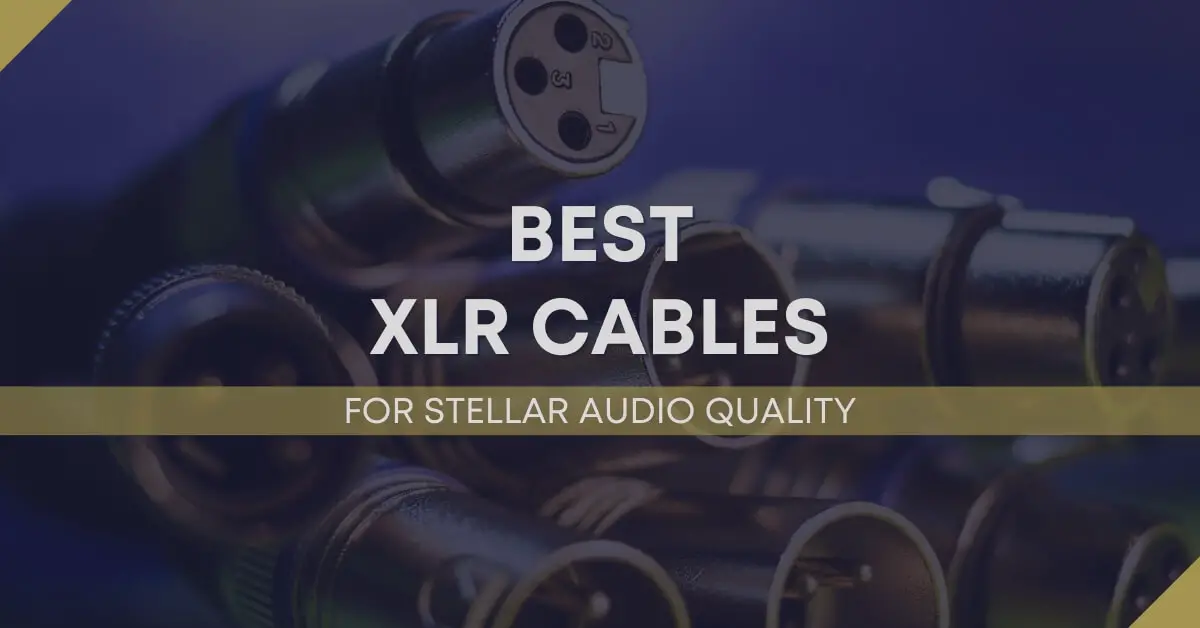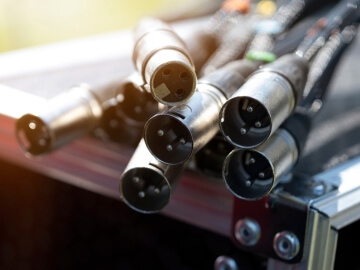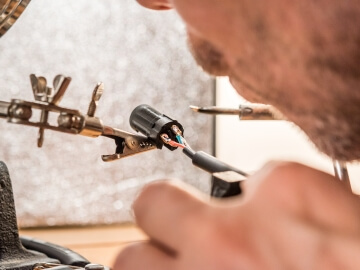
XLR cables are one of the backbones of audio setups and are used in a variety of connections, such as microphones, mixers, amps, and other audio devices. These cables are also used for various purposes, ranging from live audio and broadcasts to studio recordings.
With all the options available on the market, picking the right XLR cable can be quite overwhelming, and that’s where this guide comes in handy!
In today’s article, we’ll walk you through 5 of the best XLR cables on the market for various budgets to help you pick the ideal one for your needs.

Understanding what an XLR cable does is crucial knowledge in buying the right one. It helps you narrow down your scope and choose the best one for your needs based on the cable’s capabilities.
An XLR cable is a type of balanced audio wire/cable that functions as a conductor and is used in various audio applications.
XLR cables have a very similar internal structure to TRS cables, but they have different exterior structures and connector appearances, which is one of the main differences between the two.
The cable has a circular connector with three pins, which are positive, negative, and neutral (ground), each with its specific purpose. This is opposite to unbalanced cables, which only have two wires: a ground connection, and a positive connection.

The positive and negative wires of the balanced cable carry the same audio signal but with opposite charges, depending on the wire’s polarity.
However, one of the audio signals is inverted when both signals reach the end of the chain so that both signals are identical with the same polarity.
When electrical noise interferes with the audio signal from the cable, it enters both the positive and negative wires.
But unlike the original signal, when the interference noises are inverted and combined at the end of the chain, they remain oppositely charged, so they eventually cancel each other. As a result, the only audio signal that reaches the device is the original one.
Due to this intricate design, balanced cables are typically more expensive than unbalanced, which are highly susceptible to audio interference from external electromagnetic fields, especially when used with long cables.
The main use of XLR cables is to connect microphones to deliver balanced, line-level signals over long distances. This is thanks to their ability to cancel out interference noise and deliver crisp sound quality.
However, thanks to their unique properties, they can be also used for other applications, including speakers and mixers, some audio equipment, as well as stage lighting systems (depending on who you talk to).
Related Article: XLR Vs USB Mics: Similarities, Differences, Uses, & Recommendations
Now that you know more about XLR cables, how they work, and what they’re used for, it’s time to find out more about the best options that the market has to offer.
In this section, we’ll walk you through our top 5 recommendations to suit different budgets and requirements.
Kicking off the list with one of the best options on the market, Mogami has been a leader in cable manufacturing for decades. Their Gold Stage cable is considered - by many - an industry standard when it comes to cabling.
The Mogami Gold Stage XLR microphone cable is designed so that it’s nearly indestructible with an abuse-proof and road-proof design.
According to the manufacturer, this cable has a flex cycle rating of around 131,000. This means that it can withstand bending and torsion thousands of times.
The cable is fortified with a dense braided 0.05 mm copper shield that is around three times thicker than typical microphone cables and covers 95% of its length for additional protection.
Lastly, like other products from Mogami, this one comes with a free lifetime warranty that covers the cable against all kinds of defects and problems!
Next up, we have the Pro Co EXM microphone cable, which is also a great option to consider if you’re looking for a high-quality cable that doesn’t cost as much as the Mogami.
The Pro Co EXM is an excellent bang for the buck. The cable is designed with superior spiral shielding and oxygen-free wires to maintain clear audio quality and prevent interference and noise signals.
The cable also comes with industry-standard metal Neutrik connectors, which ensures reliable connection with devices along with added durability to withstand stage and studio abuse.
These are similar to the ones used in Mogami, so they provide a fairly similar build quality as well.
The cable also comes with an extra fortification near the connector for extra bending protection, although we would’ve loved it if the neck guard was a little longer to add a bit more shielding.
Another aspect that the Pro Co shares with the Mogami is that it comes with a lifetime warranty, which adds a lot of value to the cable’s cost.
If you’re on a tight budget and looking for an XLR that will do the trick, consider the Amazon Basics option.
As the name suggests, this one isn’t designed to be a superior option. However, it still offers decent sound quality and durability for its price.
The cable connector is made from nickel-zinc alloy, which is hard and withstands heavy use.
The cable’s wires are protected by spiral copper shielding to reduce noise interference, which can offer excellent sound quality in controlled settings like home studios.
The XLR cable is available in various sizes ranging from 3 to 50 feet, although the longer the cable, the higher the chance of picking up some noise.
Another good-quality option to consider while looking for XLR cables is the Pro Series from Warm Audio.
Although it may not look any different from a typical XLR, this one is remarkably durable without compromising flexibility.
It features a Swiss-based Gotham AG cable stock for excellent cable engineering. The cable’s wires are also fully shielded with bare copper wires for optimal protection against noise and heavy use.
The only downside here is that the Pro Series XLR cable comes with a PVC connector instead of a metal one, which is less durable despite being lighter in weight.
This makes it an excellent choice for home studios and constant setups rather than portable ones.
Yet, on the bright side, the cable comes with a lifetime warranty. This makes it a worry-free purchase without spending too much money.
Lastly, we have the Monoprice XLR cable. This one is a pretty good option for those looking for an affordable option that packs a punch!
We also like that the Monoprice cable comes in one of the largest varieties of lengths, ranging from 1.5 to 150 feet to suit various purposes and studio/stage sizes.
The XLR also features a braided design for further fortification and protection. However, the connectors are a bit loose and may come off easily.
The heavy-gauge cable features durable strand conductors with fairly low capacitance and gold-plated contacts for clear audio transmission.
Related Article: How To Set Up A Home Recording Studio For Beginners
This wraps it up for today’s guide that walks you through the best XLR cables in the industry to choose from.
As you can see, there are plenty of excellent options out there, but if you’re looking for the best in class, you should definitely go for the Mogami Gold STAGE-20 XLR Cable.
Alternatively, if you’re looking for a relatively affordable option that gets the job done, you should consider going for Pro Co EXM-20 or the Amazon Basics XLR Cable.
If you want to find out more about the best music equipment and plugins, don’t forget to subscribe to our blog!
"Some of the links within this article are affiliate links. These links are from various companies such as Amazon. This means if you click on any of these links and purchase the item or service, I will receive an affiliate commission. This is at no cost to you and the money gets invested back into Audio Sorcerer LLC."